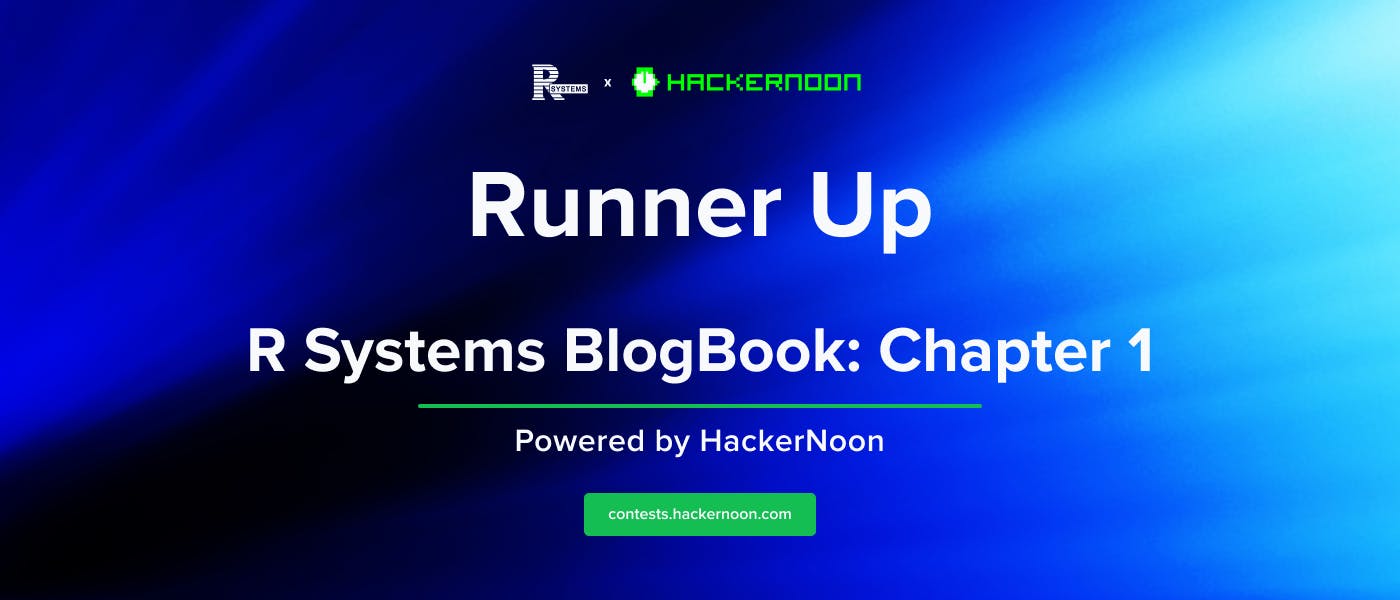There are 5.42 billion social media users in 2025. And people spend an average of more than 2 hours per day using social platforms. During that time, they create a huge amount of data. That data provides a real-time, unfiltered look at what they care about. Their conversations reveal how they feel, and what they want from the brands and organizations they deal with every day.
Social media intelligence helps turn those billions of online conversations into actionable data. Better yet, it’s data you can use right now.
Key takeaways
- Social media intelligence (SOCMINT) is the process of gathering and analyzing public social media data to support marketing, law enforcement, and policy development strategies.
- SOCMINT is a subset of open-source intelligence (OSINT) that focuses only on publicly available social media content, including posts, comments, bios, hashtags, and engagement data.
- Different professions use SOCMINT in different ways. Marketers track brand sentiment and trends, public agencies monitor safety risks or public health, NGOs gauge community needs, and journalists identify emerging stories. The key is using aggregate data responsibly and in compliance with privacy laws like GDPR, CCPA, and PIPEDA.
Social media intelligence (SOCMINT) sounds a lot scarier than it is. It’s simply the process of collecting and analyzing public data from social networking sites to support your organizational goals.
Maybe you’re working in marketing. Or policy development. Or law enforcement. For all these, social media intelligence can provide valuable insights about how people really think, feel, and act.
Marketers can use this data to spot an upcoming trend that inspires a new campaign. Public officials can use the same types of data to predict potential safety risks or even identify criminal activity.
There’s nothing nefarious here. There’s no spying or sneaking through back doors to invade privacy. SOCMINT is about turning vast amounts of public social media conversation into usable data points and actionable insights.
SOCMINT vs. OSINT: What’s the difference?
OSINT is open source intelligence. It incorporates social media intelligence as well as a whole host of other data sources. OSINT sources include everywhere we share or store public information. It also includes places the organizations and companies we deal with store public information. Some examples are:
- search engines,
- company web pages,
- online comments,
- news media,
- and public records.
SOCMINT is limited to publicly available data on social media platforms. It’s a subset of OSINT that’s more straightforward to collect, analyze, and use. Heads-up! SOCMINT is also sometimes referred to as SMI.
Public vs. private social media data
Public social media content is, well, public. It’s there, in full view, for anyone to see. This includes public social media posts, but also:
- Public comments on social posts like Facebook, X, and LinkedIn
- Employment, employer, and work history from LinkedIn or other public platforms
- Images and videos shared on platforms like Instagram, Pinterest and YouTube
- Posts and comments on social forums like Reddit
- User bios
- Locations and geotags
- Age, gender, and birthday if included in a public bio
- @mentions
- Interactions with other social platform users
- Groups joined and public interests indicated
- Events RSVPed to or expressed interest in
- Relationship status
- Hashtag and keyword use
- Follower and engagement metrics
- Follower and following graphs (aka social network mapping). These could be friends, connections, followers/following, or some other term. It just depends on the platform.
- Profile and cover photos, as well as any other public images on social media accounts. (Good SOCMINT tools include the ability to analyze images and video to determine their content.)
Private data is exactly that: private. It’s off-limits to marketers. It’s even off-limits to law enforcement without a warrant, subpoena, or court order.
So, for example, you can collect aggregate data from public Instagram posts and Reels, Tweets, and so on. But you can’t collect data from Facebook posts that are only available to the user’s friends.
Whether this data collection is legal depends, in part, on how you use it. As you’ll see later in this post, there is plenty of legislation that regulates personal data use. Keep yourself well informed about the legislation in your jurisdiction.
Structured vs. unstructured social media data
Structured data is information that would fit well into a table or chart. Think follower counts, usernames, number of likes and shares, and so on.
Unstructured data is freeform. It requires more analysis to understand what it’s all about. This can include the text, audio, image, or video content of social posts. Natural language processing tools and AI are extremely useful here.
For example, you can use SOCMINT to understand the themes of the conversations people are having about a topic on social media. You can also work out how those themes relate to other topics.
Source: Hootsuite Listening
You can gather both structured and unstructured data though SOCMINT. That is, as long as they are set to public. But unstructured data requires analysis tools. Hootsuite Listening and Talkwalker are very useful here.
Public sentiment analysis (aka opinion mining)
With SOCMINT tools, organizations can analyze all that unstructured data. They can start to understand how the public (or a subset of the public) feels about something. That could be a brand, a product, a piece of legislation, or any other issue of public interest.
Rather than diving into an individual’s social posts, social media intelligence tools analyze all relevant social posts over a set timeframe. The goal is to determine whether public opinion is positive, neutral, or negative. You can also see how sentiment changes over time.
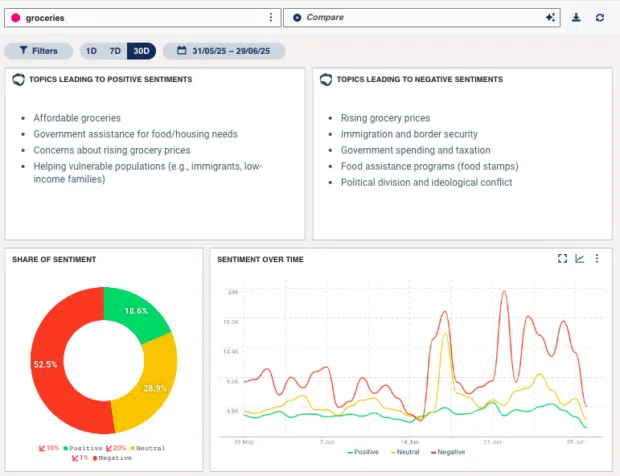
Source: Hootsuite Listening
Demographic data
For most users of social media intelligence, the goal is to gain insights into the demographics of a group of people. It’s not to work out the demographic details of any one person.
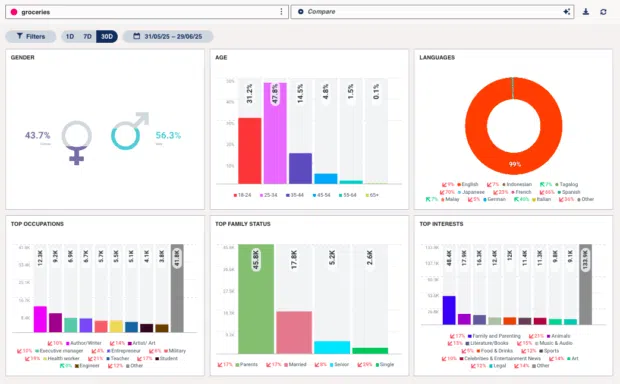
Source: Hootsuite Listening
Marketers can learn the aggregate demographics of people who interact with their social content. Public officials might want to gather aggregate demographic or location data of people who engage on specific topics. They could be especially interested in topics related to criminal activity or public threats.
As you’ve already seen, social media intelligence has broad applications. Here’s how different groups of professionals are putting it to work.
Marketing and PR professionals
For marketing and PR professionals, social media intelligence is useful for understanding public perception of a brand in real time. That includes:
It can also help you understand your target audience demographics. You can then create buyer personas and market segments.
Government and law enforcement
Governments and law enforcement agencies can use social media intelligence to identify potential threats or criminal activities by tracking public posts or discussions among social media users. For example, they might monitor the volume of conversation about a sensitive topic in a certain geographic area. They could also track the sentiment and emotions behind that topic.
Social media intelligence is also very useful for monitoring public opinion and reactions to policies, events, and campaigns. It can be used to forecast developments a couple of months in advance. This allows for effective disaster prediction and response and crisis management. It’s a useful way to track disinformation and harmful narratives. The deep insights it provides can inform a data-driven counter-strategy.
SOCMINT can also help inform emergency response strategies and public safety initiatives. It has been used effectively to track public health data and the spread of various illnesses based on users posting their symptoms. It can help officials understand population density and socioeconomic conditions in communities.
Tip: More than 2,000 government and public sector agencies already use Hootsuite Listening and Talkwalker. They are FedRAMP authorized and meet stringent global standards such as GDPR, NIST 800-53, and SOC 2.
NGOs
For NGOs, social media intelligence provides a solid understanding of public sentiment relating to social issues and events in the community in real time.
For instance, SOCMINT could help NGOs plan their business decisions based on emerging crises. These could include natural disasters, disease outbreaks, human rights abuses, or political unrest. SOCMINT can also be used to analyze campaigns already underway. It’s a way to evaluate the public response and sentiment shift.
Like brands, NGOs can use social media intelligence to identify potential partners and collaborators, like influencers and allies. They can also identify accounts that spread misinformation so they can plan an effective message to correct the record.
Finally, social media intelligence can help NGOs connect more effectively with communities. SOCMINT provides insights into the ways those communities already interact online. Where are they having authentic conversations? What topics do they talk about, and what terms do they use? Understanding these basics will allow an NGO to do more effective outreach.
Journalists
SOCMINT can help journalists get the scoop on an emerging story. Tracking relevant conversations with geographic filters can provide real-time insights into the situation on the ground.
Just as brands can dig deeper into the posts and analytics of potential influencer partners, journalists can see the most active accounts on any news subject. This gives them a list of potential sources to reach out to for comment or on-the-ground insights.
So SOCMINT is very useful for building stories. But journalists should be very careful about authentication and verification. Confirm the story from multiple sources, ideally ones you can speak to outside of social media channels. Social media intelligence can help you get ahead of the story, but it does not provide the whole story unaided.
Legal and ethical considerations
It’s important to clarify here that social media intelligence is not social media surveillance. The idea is to use big aggregate data sets rather than to dive deep into the data related to any one person. Social media surveillance strays into a gray area. Investigators could join a private group or send a friend request to access data that’s not out in the open. Again, that’s not what we’re talking about here, as it would certainly raise privacy concerns.
In fact, a good SOCMINT tool like Talkwalker or Hootsuite Listening will even use AI functionality to create short, easy-to-understand summaries of the data. This makes it more useful with even less direct observation.
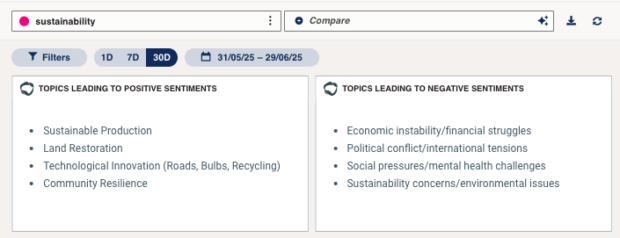
Source: Hootsuite Listening
One exception to note here: Looking for potential influencers to partner with. In this case you can use social media intelligence data to understand their content and engagement data. It gives you a sense of how good a fit they might be for your brand.
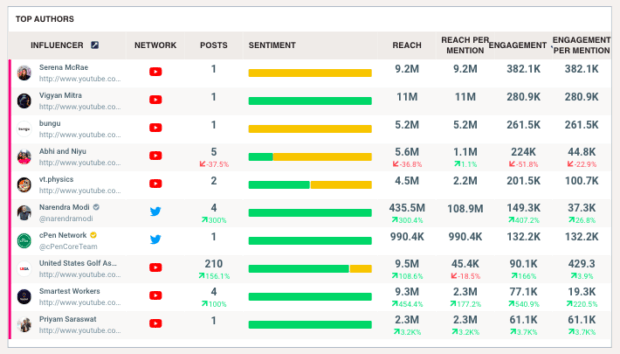
Source: Hootsuite Listening
And, just to hammer it home yet again, social media intelligence focuses on publicly available data.
Still, even public data must be used responsibly. Public opinion does not favor brands or organizations that use social media data for purposes seen as contrary to the public good. There’s also legislation in place that limits how you can use and store public data. This will vary by jurisdiction, but some of the big ones to understand include:
- GDPR (General Data Protection Regulation). This EU regulation requires anyone gathering personal data from social media to get consent from the user. That includes providing the reason for collecting the data. There are significant penalties for non-compliance. If you’re gathering social media data in the EU, your best bet is to stick with aggregate data rather than personal data for individual users.
- CCPA (California Consumer Privacy Act). This California law is similar to the GDPR. Its main provisions include rights to knowledge about personal data use, including the purpose, the right to delete data, the right to opt out of sharing or sale, the right to correct data, and to limit its use and disclosure.
- PIPEDA (Personal Information Protection and Electronic Documents Act). This Canadian law is similar to GDPR and CCPA. Again, it limits how organizations can use personal data. It requires that individuals have knowledge of and access to their data, and provide consent for its collection.
The social platforms themselves also have restrictions about data scraping in their terms of service.
The simplest way to stay compliant with these ever-evolving regulations and guidelines is to use a SOCMINT tool that itself is designated compliant. Hootsuite Listening and Talkwalker are both compliant with GDPR, CCPA, and PIPEDA. Learn more in the Hootsuite Trust Center.
We said above that SOCMINT is a subset of OSINT. Social listening is in turn a subset of SOCMINT. Social analytics is a little different, although it also clearly involves analysis. All use social data, but they use that data differently. Here’s a simple breakdown.
SOCMINT
SOCMINT is the process of collecting and analyzing data from public social media content. It’s often used for strategic decision-making or to inform security practices. It generally focuses on aggregate data and trends.
SOCMINT includes the use of natural language processing and image analysis tools to understand unstructured social data.
Social listening
Social media listening involves tracking more specific social data. Think individual keywords, brand names, or hashtags. It’s often used to:
- gauge brand reputation,
- understand the competitive landscape,
- and guide digital marketing strategy in the shorter term.
For example, it could provide inspiration for a new campaign.
Social analytics
Social analytics focuses on analyzing structured data for your own social accounts. It looks at metrics like reach, engagement, link clicks, and so on.
It’s used for things like:
- campaign reporting,
- ROI tracking,
- testing,
- and optimizing your social strategy over time.
Social media analytics requires the use of social analytics tools and reports, rather than social listening or SOCMINT tools, to help you make informed decisions.
Track data across millions of online sources, reduce risk, and analyze information faster than ever with Hootsuite Listening powered by Talkwalker.







